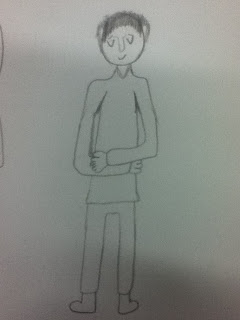Our current animation project involves studying how a character would act, based on a particular emotion. The emotion I have been given is Pride. In this blog post, I've attempted to break down what pride could mean and how it could be interpreted in many different ways.
Pride is most commonly defined by dictionaries as:
"A feeling or deep pleasure or satisfaction derived from one's own achievements, the achievements of those with whom one is closely associated, or from qualities or possessions that are widely admired."
Pride is an emotion which can be quite diverse because it can lead to so many other emotions - it all depends on the person, as pride can affect people in different ways. It might make you feel really good about yourself and you want to try achieving something great again. You might not want to stop talking about how proud you feel - both when you're reminding yourself how happy you are, or when you're boasting to other people. The latter is a common effect from pride - vanity. Vanity is an emotion which can then lead to unhappiness because you've achieved what you want, and you have nothing left to aim for. Pride is also an emotion which happens from something unexpected happening - you may not have expected to achieve what you did, or you may have dreamt of achieving it for a long time. Either way, you feel satisfied when you've first achieved it.
As a verb, "pride" can also refer to perfection - if you pride yourself in doing something. Being a perfectionist can lead to anger, stress, depression, anxiety, disssatisfaction and so on. You may also look and/or feel sleep deprived if you are working too hard. If this is the case, you're also bound to be dissatisfied with what you've achieved and still think you could do better.
 |
| Proud, content smile |
- to feel big and powerful, confidence and satisfaction with themselves.
- contented smile & eyes that look down people. Pleasure with ones self standing tall to make yourself seem big.
These descriptions helped me to decide how to look at pride using facial features such as the mouth and eyes, which are most important for reading what a person is thinking.
| A common posture and facial expression related to pride - feeling boastful. |
Each facial expression can explain what sort of pride that person is feeling - the look in one's eyes or having a smile or a frown can make all the difference.
Both these facial expressions above show the pleasure of having achieved a goal; celebrating victory.
These also show actions that the character may perform when feeling proud, such as waving ones arms around or jumping for joy. Facial expressions might show thinner eyes (reduced vision) or feeling tearful if the person feels exceptionally proud, or even angered. The mouth could be wide open when shouting for joy or in anger, or the mouth may remain closed when you're trying to contain your excitement.
Below, I have drawn some very rough sketches to interpret and translate onto paper what pride may look like, based on the research I have conducted so far.
These are very rough designs based on pride as an emotion.
The following excerpt - the prologue from 'The Lion King' (1993) - is an example of how pride has successfully been portrayed in 2D animation.
The characters are proud because it is the presentation of Simba, the newborn son of Mufasa. The thin eyes, dropped eyelids, relaxed eyebrows and large, possibly exaggerated smiles all show the characters are delighted and tearful with joy. Only the upper eyelids have been pulled up.
In contrast, the character of Victor Quartermaine from 'Wallace & Gromit - The Curse of the Were-Rabbit' (2005) shows the negative connotations of pride throughout the entire film. He is a snooty, boastful character seeing himself as very upper-class. Victor is after a wife who has plenty of money, so his facial expressions display such features as a disapproving frown, a raised, long nose and again dropped eyelids, but this time with very highly raised eyebrows. Both the upper and lower eyelids have been pulled up.
----







Great post! TVS Cube’s 3D character modeling services focus on realism and detail, crafting lifelike characters that perfectly enhance storytelling in films, games, and animations.
ReplyDelete